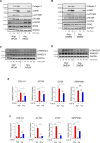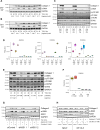Arginine promotes the activation of human lung fibroblasts independent of its metabolism
- PMID: 40454944
- PMCID: PMC12235046
- DOI: 10.1042/BCJ20253033
Arginine promotes the activation of human lung fibroblasts independent of its metabolism
Abstract
Arginine is a conditionally essential amino acid with known roles in protein production, nitric oxide synthesis, biosynthesis of proline and polyamines, and regulation of intracellular signaling pathways. Arginine biosynthesis and catabolism have been linked to transforming growth factor-β (TGF-β)-induced activation of fibroblasts in the context of pulmonary fibrosis; however, a thorough study on the metabolic and signaling roles of arginine in the process of fibroblast activation has not been conducted. Here, we examined the role and regulation of arginine metabolism in lung fibroblasts activated with TGF-β. We found that TGF-β increases the expression of arginine biosynthetic and catabolic enzymes in lung fibroblasts. Surprisingly, using metabolic tracers of arginine and its precursors, we found little evidence of arginine synthesis or catabolism in lung fibroblasts treated with TGF-β. Despite this, arginine remained crucial for TGF-β-induced expression of collagen and α-smooth muscle actin. We found that arginine limitation leads to the activation of general control nonderepressible 2 (GCN2), while inhibiting TGF-β-induced mechanistic target of rapamycin complex 1 activation and collagen protein production. Extracellular citrulline could rescue the effect of arginine deprivation in an argininosuccinate synthase-dependent manner. Our findings suggest that the major role of arginine in lung fibroblasts is for charging of arginyl-tRNAs and promotion of signaling events which are required for fibroblast activation.
Keywords: arginine; fibroblast; metabolism; pulmonary fibrosis; transforming growth factor-β.
© 2025 The Author(s).
Conflict of interest statement
The authors declare no competing interests.
Figures






Update of
-
Role of Arginine and its Metabolism in TGF-β-Induced Activation of Lung Fibroblasts.bioRxiv [Preprint]. 2024 Nov 1:2024.11.01.618293. doi: 10.1101/2024.11.01.618293. bioRxiv. 2024. Update in: Biochem J. 2025 Jun 17;482(12):BCJ20253033. doi: 10.1042/BCJ20253033. PMID: 39554075 Free PMC article. Updated. Preprint.
Similar articles
-
Role of Arginine and its Metabolism in TGF-β-Induced Activation of Lung Fibroblasts.bioRxiv [Preprint]. 2024 Nov 1:2024.11.01.618293. doi: 10.1101/2024.11.01.618293. bioRxiv. 2024. Update in: Biochem J. 2025 Jun 17;482(12):BCJ20253033. doi: 10.1042/BCJ20253033. PMID: 39554075 Free PMC article. Updated. Preprint.
-
mTOR signaling regulates multiple metabolic pathways in human lung fibroblasts after TGF-β and in pulmonary fibrosis.Am J Physiol Lung Cell Mol Physiol. 2025 Feb 1;328(2):L215-L228. doi: 10.1152/ajplung.00189.2024. Epub 2025 Jan 2. Am J Physiol Lung Cell Mol Physiol. 2025. PMID: 39745695 Free PMC article.
-
Substance P promotes transforming growth factor-β-induced collagen synthesis in human corneal fibroblasts.Am J Physiol Cell Physiol. 2024 May 1;326(5):C1482-C1493. doi: 10.1152/ajpcell.00084.2024. Epub 2024 Mar 25. Am J Physiol Cell Physiol. 2024. PMID: 38525537
-
Citrullinemia Type I.2004 Jul 7 [updated 2022 Aug 18]. In: Adam MP, Feldman J, Mirzaa GM, Pagon RA, Wallace SE, Amemiya A, editors. GeneReviews® [Internet]. Seattle (WA): University of Washington, Seattle; 1993–2025. 2004 Jul 7 [updated 2022 Aug 18]. In: Adam MP, Feldman J, Mirzaa GM, Pagon RA, Wallace SE, Amemiya A, editors. GeneReviews® [Internet]. Seattle (WA): University of Washington, Seattle; 1993–2025. PMID: 20301631 Free Books & Documents. Review.
-
The Role of Twisted Gastrulation 1 (TWSG1) Gene in TGF-β Signaling Linked to Cancer: A Comprehensive Review.Asian Pac J Cancer Prev. 2025 Apr 1;26(4):1129-1138. doi: 10.31557/APJCP.2025.26.4.1129. Asian Pac J Cancer Prev. 2025. PMID: 40302064 Free PMC article. Review.
References
MeSH terms
Substances
Grants and funding
LinkOut - more resources
Full Text Sources

